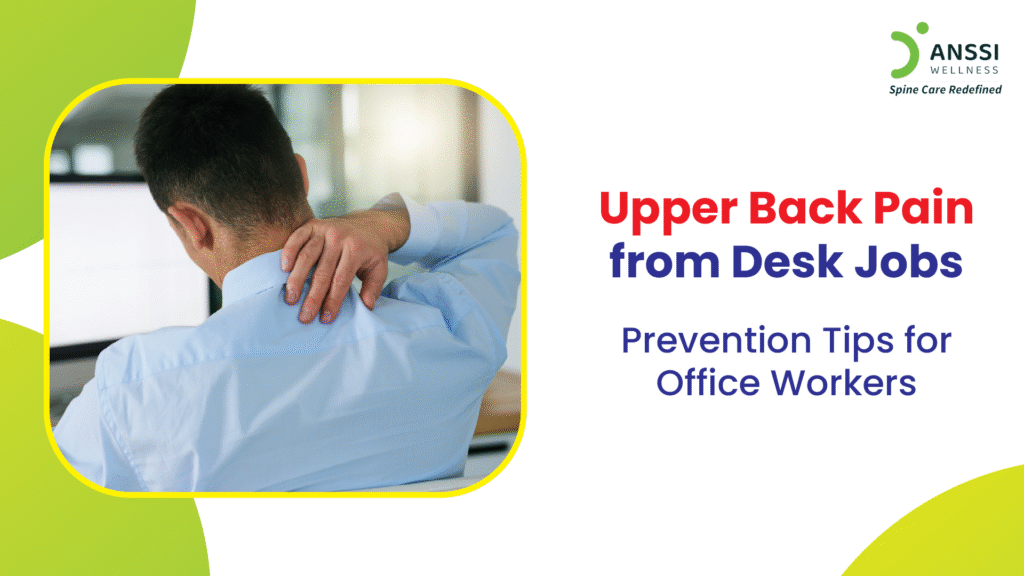In today’s fast-paced digital world, office workers, especially IT professionals, spend long hours in front of screens. While technology has boosted productivity, it has also created a new wave of health issues, with upper back pain topping the list.
The good news? With the right habits and treatment options, upper back pain is preventable and manageable.
Causes of Upper Back Pain in Desk Jobs
The combination of prolonged sitting, poor posture, and repetitive strain often leads to stiffness, discomfort, and reduced mobility.
- Poor posture and slouching: When we sit for hours, our spine naturally tends to curve forward. Slouching puts extra stress on the thoracic spine (upper back) and surrounding muscles, leading to fatigue and pain.
- Forward head position: Leaning toward the screen pulls your head forward, increasing strain on neck and upper back muscles. Over time, this creates muscle imbalances and tension.
- Lack of movement: Remaining seated for extended periods reduces blood circulation and causes muscles to stiffen. This immobility weakens supportive muscles in the back, making pain more likely.
- Stress-related muscle tension: Tight deadlines and work pressure can cause unconscious shoulder and neck tensing, contributing to upper back discomfort.
- Poor ergonomics: Improper chair height, low monitor placement, and unsupportive seating can force awkward postures, accelerating wear and tear on muscles and joints.
Health Risks of Ignoring Upper Back Pain
Brushing off upper back pain as “just work fatigue” can lead to more serious problems.
- Chronic stiffness reduces flexibility, making even simple movements uncomfortable.
- Persistent poor posture can trigger tension headaches, while muscle imbalances may cause referred pain in the arms or lower back.
- Left untreated, these issues can progress into long-term spinal conditions that are harder to manage.
Practical Prevention Tips
You can still prevent discomfort and maintain productivity.
1. Optimise Your Desk Ergonomics
Ensure your chair supports your lower back and keeps your knees at a 90-degree angle. To prevent head tilting, place your monitor at eye level. Keep your keyboard and mouse within easy reach to prevent overextension.
2. Take Micro-breaks Every 30-45 Minutes
Standing, stretching, or walking for even 2-3 minutes can dramatically improve blood flow and prevent muscle fatigue. Use reminders or apps to ensure you move regularly.
3. Practise Daily Stretches
Incorporate simple movements such as shoulder rolls, chest openers, and neck stretches. These help release muscle tension and maintain spinal flexibility.
4. Strengthen Your Upper Back Muscles
Targeted exercises such as scapular squeezes, resistance band rows, and wall angels improve posture and help prevent slouching. A stronger upper back supports better spinal alignment.
5. Protect Your Eyes to Protect Your Posture
Screen glare and poor lighting can cause you to lean forward. Adjust screen brightness, use anti-glare filters, and follow the 20-20-20 rule (look 20 feet away for 20 seconds every 20 minutes).
Advanced Non-Surgical Relief Options
For persistent or recurring upper back pain, advanced non-invasive treatments can help.
- Spinal decompression, a gentle, USA-protocol-based treatment, can relieve pressure on spinal discs and nerves.
- Physiotherapy programs focused on posture correction restore natural alignment and reduce muscle strain.
These approaches are drug-free, injection-free, and surgery-free, making them safe options for long-term spine health.
About ANSSI:
ANSSI Wellness focuses on improving the quality of life for patients suffering from spinal issues, aiming to provide relief where other conventional treatments have failed. Through advanced non-surgical spinal decompression treatment, ANSSI is committed to helping patients avoid surgery and recover in a safe, effective, and compassionate environment.
Connect with ANSSI Wellness on LinkedIn, Instagram, and Facebook for expert guidance.




